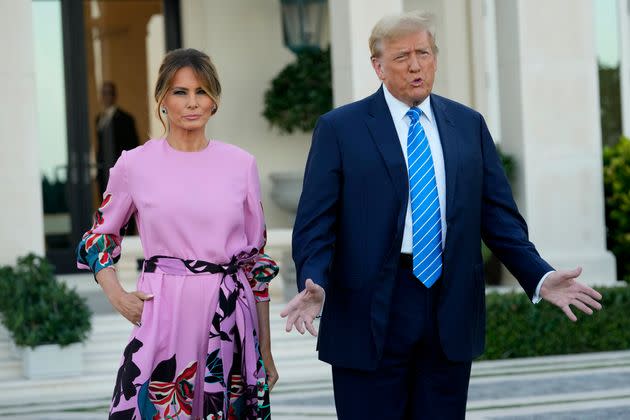Trump’s Hopes Of Erasing Biden’s Financial Advantage Rest With His Small-Dollar Army

WASHINGTON — Even as he collects checks as big as $814,600 for his campaign efforts, Donald Trump’s hopes of erasing President Joe Biden’s current financial advantage in the 2024 election likely rest with his millions of followers who over eight years have already given him $1.5 billion in small-dollar donations.
“And they’re happy to give it,” said one Trump campaign adviser who spoke on condition of anonymity. “There’s fatigue, obviously. But other than Obama, he’s the best there is. Certainly the best Republicans have ever had.”
Barack Obama broke fundraising records in the 2008 presidential election and created a new paradigm for political campaigns by aggressively seeking out donors who would give $20, $10 or even $2, but would do so on multiple occasions.
Trump became the first Republican presidential candidate to successfully follow that model during his 2016 run. In his 2020 reelection campaign, he raised $953 million by sending his supporters repeated text message and email solicitations, compared with $496 million from those attending expensive fundraising events.
But the coup-attempting former president continued hitting up his followers for money after losing in 2020, at first by falsely claiming he would use it for legal challenges to the election result, and then by claiming he needed it to push his agenda, even though more than $100 million of the $347 million he raised through his Save America fundraising committee went to pay his legal bills.
Trump’s 2024 campaign said it raised more than $50 million at a fundraiser in Palm Beach, Florida, earlier this month. That was followed by a $5 million event in Atlanta and an $8 million gathering in Orlando, as well as numerous smaller lunches and dinners at his West Palm Beach golf course and elsewhere that picked up between a half-million dollars and $2 million, the adviser said.
According to top Republicans, the campaign has an overall goal of raising between $750 million and $1 billion between March — when Trump locked up his third straight Republican nomination — and Election Day in November to run a competitive race against Biden.
But there are only so many billionaires and millionaires in America able and willing to write five- and six-figure checks to a presidential campaign, meaning that Trump again will be turning to his small-dollar donors to produce big money.
“He’s going to need it this year, because he’s got nothing in the bank,” said a Republican National Committee member who also spoke on condition of anonymity.
Whether that’s probable or even possible cannot be known just yet — the new vehicle for his small-dollar fundraising, the so-called Trump National Committee, was only formally organized in late March. In its first filing with the Federal Election Commission on Monday, it reported raising and spending exactly $0 through March 31.
Trump’s new large-dollar committee, the Trump 47 Committee, meanwhile reported raising $23.6 million — the vast majority of which is included in the $50 million figure from the April 6 fundraiser.
“They were pushing to get money in by the end of the month,” the Trump adviser said, to boost the number reported at quarter’s end to the FEC.
The first $6,600 of every check given to Trump 47 goes to the Trump campaign, and the next $5,000 goes to Trump’s Save America committee, which he can use for personal expenses and has been using to pay his legal fees. Money beyond that $11,600 total goes to the RNC and state Republican parties.
From the 71 donors listed in Trump 47’s first FEC filing, for example, $355,000 would go to Trump’s personal committee.
In its first quarter filing with the FEC, Trump’s Save America Joint Fundraising Committee reported having $13.7 million in cash, some of which is also likely to be transferred to the committee paying Trump’s legal bills, which have exploded in recent years and show no signs of diminishing soon.
Trump was sued by the New York state attorney general in 2022 for fraud based on his decades of overstating the value of his properties to get better terms from banks and insurers. He lost the case and is now appealing the $454 million judgment.
He is also facing four separate criminal prosecutions — two based on his actions leading up to and on Jan. 6, 2021, when a mob of his followers attacked the U.S. Capitol in an attempt to keep him in power.
A federal indictment could go to trial as early as late August, depending on the timing of a Supreme Court ruling on his claim that he is immune from prosecution. A Georgia state prosecution based on his attempt to overturn his election loss in that state could also start later this year.
A New York state prosecution on charges that he falsified business records to hide hush money payments in the days before the 2016 election began jury selection Monday, while a federal prosecution based on his refusal to turn over secret documents that he took with him from the White House to his South Florida country club has not yet been set for trial.
And in a separate civil case, a New York jury last year found that Trump had sexually penetrated writer E. Jean Carroll against her will in an incident in the 1990s, finding him civilly liable for sexual abuse. The federal judge in the case later clarified that Trump’s actions were rape in the “common modern parlance.”

